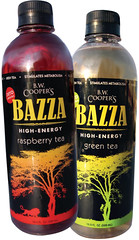Yay! A new low-calorie energy drink that doesn’t taste like ass!
In recent years, the bottled drink market has been flooded with a variety of so-called "energy drinks" that claim to use natural (and sometimes not-so-natural) ingredients to boost energy better than the standard caffeinated and sugar-filled drinks. Whether the claims are true or not is a matter of some debate. Most of these drinks contain a higher quantity of caffeine than what the FDA recommends for standard soft drinks (68 mg. per 12 oz. serving). One might unscientifically conclude that the energy drinks get most of their oomph from the extra caffeine and sugar rather than from any herbal additives.
Personally, I do not care either way. Almost every one of the energy drinks I have tried has tasted so nasty that I concluded that any buzz I might gain from them is not worth the effort. Until recently, the only exception to that has been Bawls Guarana — not the sugar-free Bawls Guaranexx, which tastes as nasty as the other energy drinks — but for 80 mg. of caffeine per 12 oz., I would rather drink something with less than 100 calories, like unsweetened coffee or a diet cola.
 Enter BAZZA High-Energy Tea.
Enter BAZZA High-Energy Tea.
I first noticed this recent addition to the energy drink market a few weeks ago at my local 7-Eleven. I didn't give it much thought beyond an "oh, great, now they're making energy teas." Then the press release for BAZZA came across my inbox, so I decided to give it a try. Color me impressed.
Right now the drink comes in two flavors: raspberry tea and green tea. I had both, and they are quite tasty. In fact, they do not taste like a sugar-free diet drink at all. I prefer the green tea over the raspberry because it is not as sweet-tasting, but your mileage may vary.
As for the buzz, the 99.4 mg. of caffeine per 12 oz. is making its presence known throughout my nervous system. I feel far more jumpy and awake than I normally would, given the amount of sleep I have had recently.
If you are looking for a low-calorie high-energy drink alternative, give the BAZZA High-Energy Tea a try. Just be careful — too much caffeine can kill you.




